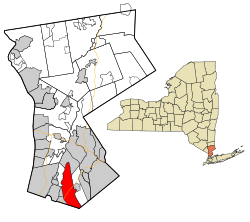New Rochelle (NY)
| New Rochelle, New York | ||
|---|---|---|
| City | ||

Main Street and Huguenot Street in New Rochelle
|
||
|
||
| Nickname(s): Queen City of the Sound | ||
| Motto(s): Nunquam Retrorsum (Never Backward) |
||
 Location within Westchester County and the state of New York |
||
| Coordinates: 40°54′41″N 73°46′56″W / 40.91139°N 73.78222°WCoordinates: 40°54′41″N 73°46′56″W / 40.91139°N 73.78222°W | ||
| Country | United States | |
| State | New York | |
| County | Westchester | |
| Incorporated (city) | 1899 | |
| Government | ||
| • Type | Council-Manager | |
| • Mayor | Noam Bramson (D) | |
| Area | ||
| • Total | 13.23 sq mi (34.28 km2) | |
| • Land | 10.35 sq mi (26.81 km2) | |
| • Water | 2.88 sq mi (7.47 km2) | |
| Elevation | 85 ft (26 m) | |
| Population (2010) | ||
| • Total | 77,062 | |
| • Estimate (2016) | 79,557 | |
| • Density | 7,686.67/sq mi (2,967.76/km2) | |
| Time zone | Eastern (EST) (UTC-5) | |
| • Summer (DST) | EDT (UTC-4) | |
| ZIP codes | 10801, 10802, 10804, 10805 | |
| Area code(s) | 914 | |
| FIPS code | 36-50617 | |
| GNIS feature ID | 958451 | |
| Website | Official website | |
New Rochelle /rəˈʃɛl/ is a city in Westchester County, New York, United States, in the southeastern portion of the state.
In 2007, the city had a population of 73,260, making it the seventh-largest in the state of New York. As of the 2010 Census, the city's population had increased to 77,062. In November 2008 Business Week magazine listed New Rochelle as the best city in New York State, and one of the best places nationally, to raise children. In 2014, based on analysis of 550 U.S. cities, New Rochelle was voted the 13th best city to live in.
The European settlement was started by refugee Huguenots (French Protestants) in 1688, who were fleeing religious persecution in France (such as dragonnade) after the revocation by the king of the Edict of Nantes. Many of the settlers were artisans and craftsmen from the city of La Rochelle, France, thus influencing the choice of the name of "New Rochelle".
Some 33 families established the community of la Nouvelle-Rochelle in 1688. A monument containing the names of these settlers stands in Hudson Park, the original landing point of the Huguenots. Thirty-one years earlier, the Siwanoy Indians, a band of Algonquian-speaking Lenape (also known as the Delaware by English colonists) sold their land to Thomas Pell. In 1689 Pell officially deeded 6,100 acres (25 km2) for the establishment of a Huguenot community. Jacob Leisler is an important figure in the early histories of both New Rochelle and the nation. He arrived in America as a mercenary in the British army and later became one of the most prominent merchants in New York. He was subsequently appointed acting-governor of the province, and it was during this time that he acted on behalf of the Huguenots.
...
Wikipedia

